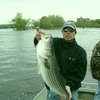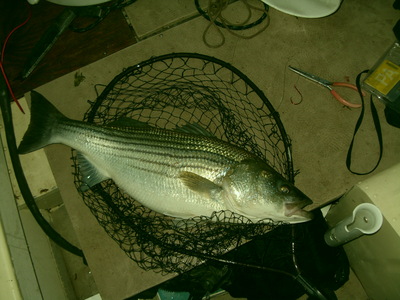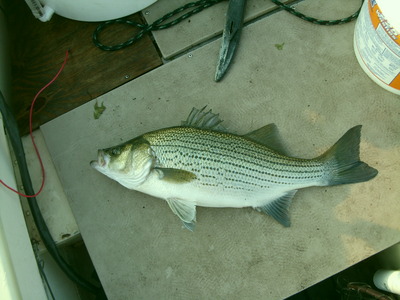Fishing for striped bass at Trenton can be explosive action with herring being tossed out of the water by big stripers. It can also provide some of the best shallow water sight fishing that I have ever witnessed. The combination of the swift current and the massive size and force of just a normal striper can put a bend in any class rod.
To get started fishing Trenton for Stripers in the spring migration you will need a few things;
You will need a boat, preferably a jet drive boat or rock boat. If you do not have a jet boat a shallow running jon boat with a prop will work but your water reading skills will have to be up to par.
A heavy river anchor is a must! Nothing is as bad as breaking loose when you don't want to.
Too many bad things can happen quickly. Wedged up on rocks, drifting into another boat, or being flipped by a bridge pilling, swift water in the 50's and 60's water temperature is not a pleasant experience!
The thing next you will need is the right Rod and reel, I use St. Croix rods. The best rod I have found for plugging and flipping herring is an 8 foot long rod 12-25lb class with a bait runner reel loaded with 200-310 yards 15-17lb test.
For the leader material I use Seaguar fluorocarbon 25-30lbs. The reason I go so heavy is that the combination of shallow water and obstructions such as rocks, trees, and city debris. It is not uncommon to see a shopping cart or a full size dumpster wedge in between to big rocks.
The hooks I like to use are a small treble hook that is a 4x strength with a thick shank j hook. The Trenton stinger rig has worked for so many years and provides the best hook-up ratio, but in the day of circle hook and conservation I have surrendered to using circle hooks. It does make a difference; a gut hook female bass most likely will not survive which means the eggs in her belly will never become baby stripers which in turn will not get to grow to be a monster bass that everyone seeks to catch. It is amazing how a circle hook can provide you with the satisfaction of a good corner of the mouth hook set and at the same time frustrate you with the amount of run offs that you can have, do to the position of the herring in the bass's mouth or the hook turns into the herring and the hook never gets a chance to do it's job. I have let bass eat for up to 20 seconds and still have missed the fish. It takes time to master the art of circle hooks in a fast current situation, especially when the fish is running down stream and you pull tight and the herring slips out of the striper's mouth. Now that we have gone over the equipment lets talk about catching bait.
A live well or bait tub preferably round with a Circulation pump. I use a 20 gallon round tub with a drain hole at the top for over flow. For the Circulation pump I use an 800 gph bilge pump with about 6 feet of hose and a 90 degree valve inside the tub. The pump sits in the water off the side of the boat. This will give you fresh water from the river and circulate the water at the same time.
Catching herring use to be a fun event and this is what people use to go out fishing for. Now it has become only work and just a bait source for stripers. We use to tie are own rigs which consisted of three gold hooks size 8-12. Now there are rigs called sabiki rigs that are small gold hooks with iridescent wings that seem to be the norm no a days. The best color to me is the white but green does work. I like to take the green beads of my white rigs it seems to catch more fish. On certain days you can use larger rigs and on other days the guy with the smallest rig will be the only one putting the fish in the live well. The best thing to do is to go out and by a number of different styles and see what works for you. Storing these rigs can really be a pain, I found that a pole noodle float cut to about 6 inches works the best. Just wrap the rig around the noodle and put each hook into the foam and pinning the swivel with a tooth pick as well as the snap. This keeps each rig nice and neat avoiding the tangles that happen all too often with sabiki rigs.
Finding herring can be done by three ways, watch other fishermen and see who is catching them consistently and move near them without encroaching on there fishing space. The next way is by using a good fish finder. Locate the school of fish and drop a rig down before you anchor make sure they are holding below you. The last way to find them is to drift fish. Drift while jigging until you locate the herring, then take land marks and remember where you caught them. Herring normally hold in the same holes year after year. After you have loaded you live well with plenty of herring it's time to fish.
Fishing for stripers in the rocks at Trenton is just like fishing for smallmouth bass. They like the same structure, the same bait presentation, they wait in ambush points wither it's a rock shelf, a boulder, tree, dam, or a ledge, and they also love to push baits up into structure pinning them. The key for Trenton is to develop an A 1 hole that I can depend on at any tide. Once this is established I fish in a different location every trip, never getting into a routine where I just skip over spots completely. Stripers are a migratory fish feeding on migratory baits. One school of stripers may like a certain rock chute another school may never go by that rock chute. It is important to fish in different migration routes or places where stripers would find it the easiest to move up river and of course eat their lunch. I have seen so many anglers fish their favorite hole and catch no fish or a few fish and stick with their spot all day, just because one day they caught fish. It may produce fish for them but there are betters ways to find these fish. When I start fishing I always drift between the three bridges. Fishing in all possible migration routes, tide permitting. I then move up the Jersey side and take a long drift down the wall. I will then move towards the center of the river and set a long drift. I do the same thing with the Pennsylvania side as well. By now I can figure out what side of the river the bass are trending to move up. Of course if I catch fish on a drift I will continue to drift that stretch of water or anchor and drift baits back.
Once I have located fish and have decided to set the anchor down I always drift a live herring back. What I mean by live herring is not a beat up bait that does not want to swim, a fresh, lively bait that looks like candy to a striper. I see so many people toss half dead baits back into their drift, yes you will catch fish on these baits but the smart fish that are generally larger fish, will hit lively baits more often then the beat up bait. Remember the herring are free and the beat up baits will become chunk baits. As I am drifting live baits back typically with two rods, I make sure I take another rod or so and put a chunk down or maybe free line a head. This will do two things for you, One it will keep you from having a large tangle with tons of line out. (Basically cutting your four rods down to two or possibly one). Remember you have to have you line wet to catch fish. Second it covers ground. By having short baits, 3-6 feet off the corner of the boat and another bait about 10-15 feet you cover water, stay out of tangles, cover a different depth, and lastly you have a scent trail. More often than not I catch fish on the chunked heads and half bodies. When chumming as always cutting baits in small chunks as not to feed the stripers but merely an appetizer. These small pieces will also cover a lot of ground as they float down stream. A hand grinder has been one of the best tools that I have added to my boat years ago while bunker chunking. When live lining I make sure I count how many strips of line I take off my reel just like tuna fishing, that way I know where and how far back the fish are holding. Developing successful patterns and duplicating them is what fishing is all about.
Picking the right place to fish can be easy and hard. Sometimes a set of rocks or a channel looks so good that you would imagine stripers holding there but they don't. I can't tell you why but some places just don't hold fish. I tend to fish fast breaking water with a nice eddy behind the rocks. I like to anchor just above the Structure that causes the fast water and eddy. Then I pitch live baits through the chutes and let them swim for a little bit if there are no hits I let more line out till I reach the next eddy, chute, or boulder. When I am just swimming baits off the back of the boat I tend to keep a short bait, a mid range bait and a way back bait. The herrings must be able to swim in the water you are fishing or they will end up at the surface rolling. Adding a slip sinker or a fish finder will help the herring stay down in faster moving water. Drifting the rocks with the boat can be great action and will also cover a lot of territory. This can be done with one person running the boat and the other person pitching baits in the chutes and rock piles. This technique can be difficult by your self, but it can be done. You need to watch for large rocks that your boat might get hung up on or spin you around violently. Drifting with the boat has always been about boat position on the initial cast and then keeping the bait almost even with the boat. Most casts with be about twenty feet or so. You don't want to pitch your baits high in the air. This will stun or even kill your baits. What you want to do is pitch at low angle so the bait does not slap the water. You may even want the herring to skip across surface of the water once or twice on impact. Once the bait is in the water keep your rod tip up high and allow the bait to swim up and over rocks. You will target the same places that you would drift baits back to when anchored.
Plugging and artificial baits is always a great time. Early morning is the key to success. Years ago I never fished herring. We would fish plugs like fasttracs, Long A's, and poppers an hour before dawn and until about an hour after dawn. Some days we would catch 20 bass just on plugs. This seems to be a lost tactic. When plugging you could anchor, drift, or run the boat to stay even with the structure you are plugging. What I like to do is simply cast across the river to and above the structure you are targeting and let the plug or popper swim in the current and then swing back to directly behind the boat. Most of the fish you will catch will be on the swing of the plug. It is basically what you do with live baits. In the deeper water under the bridges I will work the plugs slowly and erratically. The pace of the retrieve will vary to each days conditions and tide phase.




